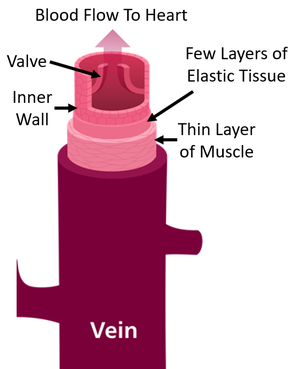Difference between revisions of "Vein"
| Line 42: | Line 42: | ||
:[https://www.amazon.co.uk/gp/product/1782945741/ref=as_li_tl?ie=UTF8&camp=1634&creative=6738&creativeASIN=1782945741&linkCode=as2&tag=nrjc-21&linkId=30da4f2178da182547b62a7329d13b57 ''Veins, page 62, GCSE Combined Science; The Revision Guide, CGP, Edexcel ''] | :[https://www.amazon.co.uk/gp/product/1782945741/ref=as_li_tl?ie=UTF8&camp=1634&creative=6738&creativeASIN=1782945741&linkCode=as2&tag=nrjc-21&linkId=30da4f2178da182547b62a7329d13b57 ''Veins, page 62, GCSE Combined Science; The Revision Guide, CGP, Edexcel ''] | ||
:[https://www.amazon.co.uk/gp/product/1782946748/ref=as_li_tl?ie=UTF8&camp=1634&creative=6738&creativeASIN=1782946748&linkCode=as2&tag=nrjc-21&linkId=a4f0348fc37d0ba1bb52d27f8679581f ''Veins, page 90, GCSE Biology; The Revision Guide, CGP, Edexcel ''] | :[https://www.amazon.co.uk/gp/product/1782946748/ref=as_li_tl?ie=UTF8&camp=1634&creative=6738&creativeASIN=1782946748&linkCode=as2&tag=nrjc-21&linkId=a4f0348fc37d0ba1bb52d27f8679581f ''Veins, page 90, GCSE Biology; The Revision Guide, CGP, Edexcel ''] | ||
| + | |||
| + | :[https://www.amazon.co.uk/gp/product/1782945695/ref=as_li_tl?ie=UTF8&camp=1634&creative=6738&creativeASIN=1782945695&linkCode=as2&tag=nrjc-21&linkId=ceafcc80bcad6b6754ee97a0c7ceea53 ''Veins, page 30, Gateway GCSE Combined Science; The Revision Guide, CGP, OCR ''] | ||
| + | :[https://www.amazon.co.uk/gp/product/1782945660/ref=as_li_tl?ie=UTF8&camp=1634&creative=6738&creativeASIN=1782945660&linkCode=as2&tag=nrjc-21&linkId=83aa4500ad7759e7f401a1c5ba5df758 ''Veins, page 37, Gateway GCSE Biology; The Revision Guide, CGP, OCR ''] | ||
| + | :[https://www.amazon.co.uk/gp/product/0198359810/ref=as_li_tl?ie=UTF8&camp=1634&creative=6738&creativeASIN=0198359810&linkCode=as2&tag=nrjc-21&linkId=d768d99f1a06f7c12fab40e5aef85a55 ''Veins, pages 75-76, Gateway GCSE Biology, Oxford, OCR ''] | ||
==Beyond the Curriculum== | ==Beyond the Curriculum== | ||
{{#ev:youtube|https://www.youtube.com/watch?v=GAPHmFjkcu4}} | {{#ev:youtube|https://www.youtube.com/watch?v=GAPHmFjkcu4}} | ||
Latest revision as of 10:50, 25 December 2019
Contents
Key Stage 3
Meaning
An vein is a blood vessel which carries blood to the heart.
Key Stage 4
Meaning
An vein is a blood vessel which carries low pressure blood to the heart.
Adaptations of Veins
- Veins have a thin layer of muscle because the blood is a low pressure.
- Veins have few layers of elastic tissue as the blood is a low pressure.
- Veins have valves in them to stop the blood flowing in the wrong direction because it is such a low pressure.
- Veins often pass between muscles which work with the valves by contracting to force the blood through the vein.
| A diagram of a vein. |
About Veins
- Most, but not all, veins carry deoxygenated blood.
- The pulmonary vein carries oxygenated blood from the lungs to the heart.
References
AQA
- Vein, pages 113, 205, GCSE Biology; Student Book, Collins, AQA
- Veins, page 31, GCSE Combined Science; The Revision Guide, CGP, AQA
- Veins, page 35, GCSE Biology; The Revision Guide, CGP, AQA
- Veins, page 78, GCSE Combined Science Trilogy; Biology, CGP, AQA
- Veins, page 84, GCSE Biology, CGP, AQA
- Veins, pages 51, 53-4, GCSE Biology, Hodder, AQA
- Veins, pages 51, 53-4, GCSE Combined Science Trilogy 1, Hodder, AQA
- Veins, pages 54-55, 141, GCSE Biology; Third Edition, Oxford University Press, AQA
Edexcel
- Veins, page 167, GCSE Biology, Pearson, Edexcel
- Veins, page 265, GCSE Biology, CGP, Edexcel
- Veins, page 62, GCSE Combined Science; The Revision Guide, CGP, Edexcel
- Veins, page 90, GCSE Biology; The Revision Guide, CGP, Edexcel
- Veins, page 30, Gateway GCSE Combined Science; The Revision Guide, CGP, OCR
- Veins, page 37, Gateway GCSE Biology; The Revision Guide, CGP, OCR
- Veins, pages 75-76, Gateway GCSE Biology, Oxford, OCR
